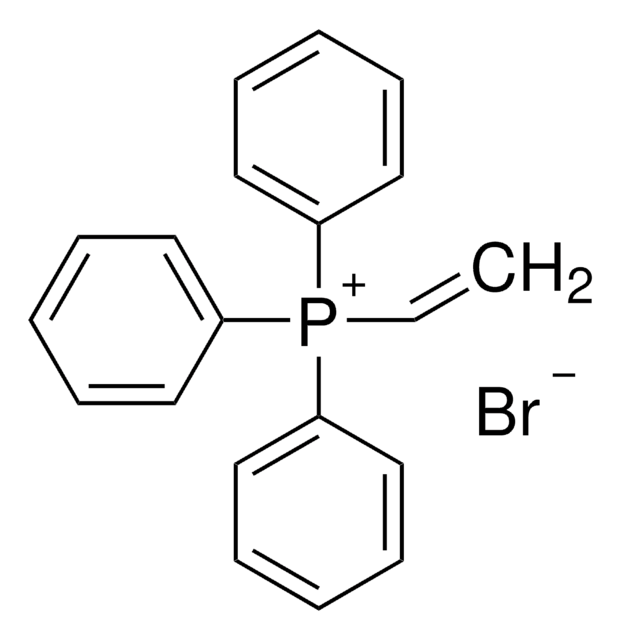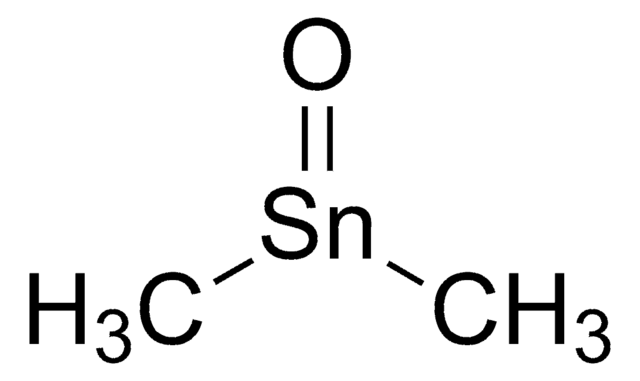全部照片(3)
About This Item
線性公式:
SnO2
CAS號碼:
分子量::
150.71
EC號碼:
MDL號碼:
分類程式碼代碼:
12352303
eCl@ss:
38140208
PubChem物質ID:
NACRES:
NA.23
推薦產品
化驗
≥99.99% trace metals basis
形狀
powder and chunks
密度
6.95 g/mL at 25 °C (lit.)
應用
battery manufacturing
SMILES 字串
O=[Sn]=O
InChI
1S/2O.Sn
InChI 密鑰
XOLBLPGZBRYERU-UHFFFAOYSA-N
尋找類似的產品? 前往 產品比較指南
一般說明
Tin(IV) oxide, also known as stannic oxide, is a yellow-green powder that crystallizes in the rutile structure. It is a wide bandgap (3.6 eV) semiconductor with high transparency in the visible range of the electromagnetic spectrum and relatively high electronic conductivity. Its chemical stability and high purity of ≥99.99% trace metals basis make it suitable for use in demanding conditions, such as semiconductor and biomedical applications, where it is widely used in medical imaging devices, biosensors, and diagnostic tools. It is also utilized in battery technologies, including lithium-ion batteries, as a conversion-type anode material due to its high energy storage capacity and stability and a precursor for making tin compounds and complex metal oxides.
應用
- Fluorinated Cation-Based 2D Perovskites for Efficient and Stable 3D/2D Heterojunction Perovskite Solar Cells.: This research explores the application of tin(IV) oxide in creating efficient and stable perovskite solar cells, focusing on the improvement of the solar cells′ overall performance (Shaw PE et al., 2023).
- Tin(IV) Oxide Electron Transport Layer via Industrial-Scale Pulsed Laser Deposition for Planar Perovskite Solar Cells.: The study discusses the use of tin(IV) oxide as an electron transport layer applied through industrial-scale pulsed laser deposition, enhancing the functionality and efficiency of planar perovskite solar cells (Bolink HJ et al., 2023).
- Periodic Acid Modification of Chemical-Bath Deposited SnO2 Electron Transport Layers for Perovskite Solar Cells and Mini Modules.: This paper presents a methodology for the modification of SnO2 electron transport layers, used to increase the efficiency of perovskite solar cells and mini-modules (Lin H et al., 2023).
- Zwitterion-Functionalized SnO2 Substrate Induced Sequential Deposition of Black-Phase FAPbI3 with Rearranged PbI2 Residue.: Research on enhancing the deposition of black-phase FAPbI3 on zwitterion-functionalized SnO2 substrates, focusing on perovskite solar cell improvements (Zhao Y et al., 2022).
- Improved stability and efficiency of polymer-based selenium solar cells through the usage of tin(iv) oxide in the electron transport layers and the analysis of aging dynamics.: The study investigates the role of tin(IV) oxide in enhancing the stability and efficiency of polymer-based selenium solar cells (Zhang Q et al., 2020).
儲存類別代碼
11 - Combustible Solids
水污染物質分類(WGK)
nwg
閃點(°F)
Not applicable
閃點(°C)
Not applicable
個人防護裝備
Eyeshields, Gloves, type N95 (US)
分析證明 (COA)
輸入產品批次/批號來搜索 分析證明 (COA)。在產品’s標籤上找到批次和批號,寫有 ‘Lot’或‘Batch’.。
客戶也查看了
Li-Ping Li et al.
Chemical communications (Cambridge, England), 49(17), 1762-1764 (2013-01-25)
ZnSn(OH)(6) and binary-component SnO(2)-ZnSn(OH)(6) were introduced as affinity probes for phosphopeptide enrichment for the first time. Two strategies, either ZnSn(OH)(6) and SnO(2) serial enrichment or binary-component SnO(2)-ZnSn(OH)(6) enrichment in a single run, were proposed to enhance multi-phosphopeptide enrichment and to
Dawei Su et al.
Chemical communications (Cambridge, England), 49(30), 3131-3133 (2013-03-13)
An in situ hydrothermal synthesis approach has been developed to prepare SnO2@graphene nanocomposites. The nanocomposites exhibited a high reversible sodium storage capacity of above 700 mA h g(-1) and excellent cyclability for Na-ion batteries. In particular, they also demonstrated a
Lina Gao et al.
Langmuir : the ACS journal of surfaces and colloids, 29(3), 957-964 (2012-12-25)
As advanced electrodes for direct alcohol fuel cells, graphene-Pd and graphene-Pt composites with a trace of SnO(2) have been successfully synthesized by a modified electroless plating technique. The surface of graphene oxide is first sensitized by Sn(2+) ions, and subsequently
Junfei Liang et al.
ACS applied materials & interfaces, 4(11), 5742-5748 (2012-10-24)
A flexible free-standing graphene/SnO₂ nanocomposites paper (GSP) was prepared by coupling a simple filtration method and a thermal reduction together for the first time. Compared with the pure SnO₂ nanoparticles, the GSP exhibited a better cycling stability, because the graphene
Ilsun Yoon et al.
Nanoscale, 5(2), 552-555 (2012-12-13)
Here we demonstrate a facile method of quantifying the decaying optical field surrounding free-standing tin dioxide (SnO(2)) nanofiber waveguides. Through the use of thin self-assembled polyelectrolyte coatings and fluorescent optical transmitters we map out the optical intensity as a function
我們的科學家團隊在所有研究領域都有豐富的經驗,包括生命科學、材料科學、化學合成、色譜、分析等.
聯絡技術服務













